Nestled deep in Sapa Valley, Ta Van Village is a serene retreat where travelers can immerse themselves in Vietnam’s authentic mountain life. Surrounded by terraced rice fields and mist-covered hills, Ta Van offers a glimpse into the daily rhythms of ethnic minorities like the Giay and Hmong people. This peaceful destination combines breathtaking scenery with genuine cultural experiences, from homestays to traditional meals shared with local families. Whether you seek adventure, photography, or simply a slower pace of life, Ta Van Village captures the soul of Sapa through its beauty, warmth, and simplicity. It’s not just a place to visit — it’s a place to belong.
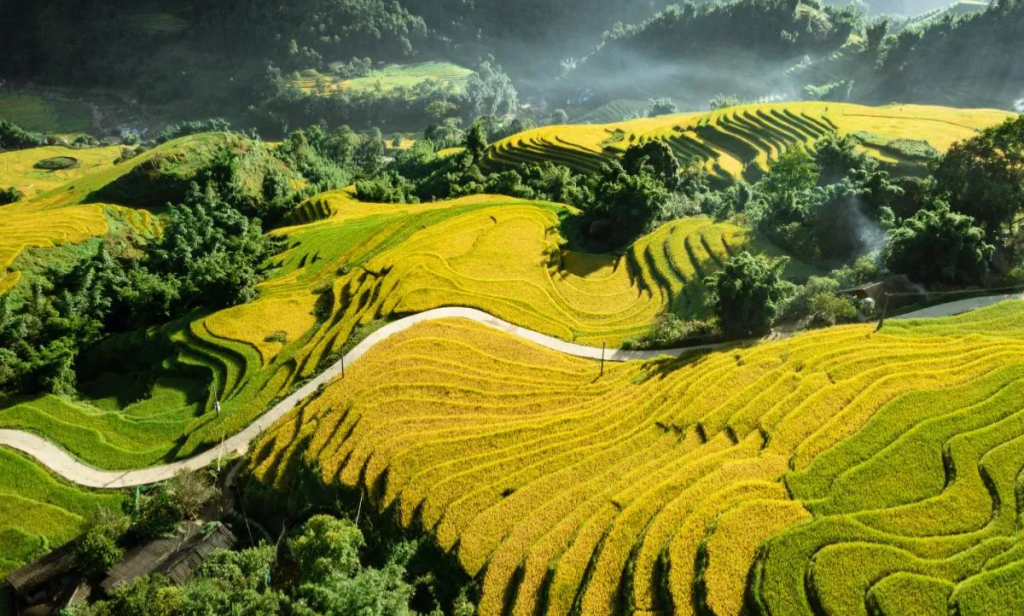
Image for illustrative purposes only. Source: Collected online.
1. Introduction: The Heart of Sapa Valley
At the very core of Sapa’s beauty lies Ta Van Village — a peaceful community that embodies the balance between culture, nature, and authenticity. Tucked within the emerald valleys of northern Vietnam, Ta Van offers a deep sense of connection to both the land and its people. This section introduces the essence of Ta Van Village, its setting, and why it represents the most genuine face of Sapa.
Where Nature Meets Simplicity
Located about 8 kilometers from Sapa Town, Ta Van Village sits in the heart of Muong Hoa Valley — a landscape painted with cascading rice terraces, crystal streams, and mist-shrouded mountains. The moment travelers arrive, they are greeted by the tranquil rhythm of rural life: farmers tending to rice paddies, buffaloes grazing lazily, and children playing by the roadside.
Unlike the busier tourist spots nearby, Ta Van moves at its own quiet pace. The road leading into the village winds through vibrant fields and traditional stilt houses, offering glimpses of Sapa’s ethnic diversity and charm. As morning mist lifts over the valley, the entire scene glows with a soft golden hue — an invitation to slow down and breathe.
Highlights of Ta Van’s landscape:
- Vast rice terraces stretching across the Muong Hoa Valley.
- Wooden houses built on stilts overlooking streams.
- Evergreen mountains and misty horizons perfect for sunrise views.
Every corner of Ta Van feels like a watercolor painting — vivid yet calm, rustic yet alive.
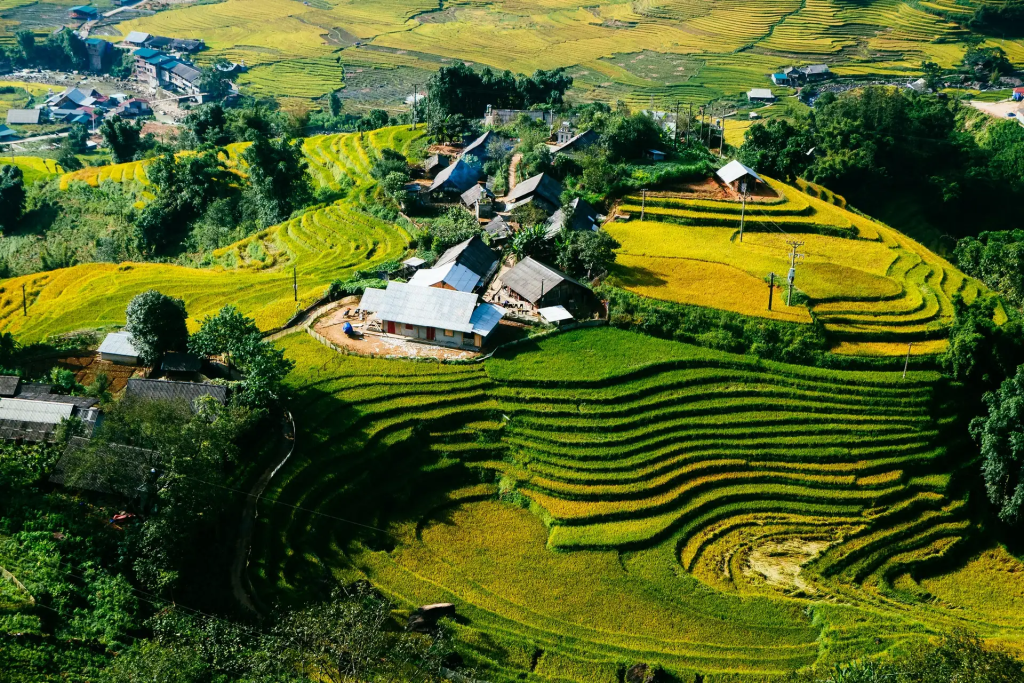
Image for illustrative purposes only. Source: Collected online.
A Cultural Sanctuary in the Highlands
Beyond its scenic beauty, Ta Van is home to a blend of ethnic communities including the Giay, Hmong, and Dao peoples. Their colorful clothing, traditional crafts, and kind hospitality add layers of richness to the landscape. Visitors who stay overnight in family-run homestays often share home-cooked meals, stories, and laughter around the fire.
Here, tourism doesn’t disrupt daily life — it complements it. Locals proudly preserve their customs while welcoming guests with genuine warmth. Whether it’s learning to weave, tasting local corn wine, or joining a morning trek, each encounter leaves travelers feeling deeply connected.
What makes Ta Van culturally special:
- Harmonious coexistence of multiple ethnic groups.
- Opportunities for travelers to live like locals.
- Preservation of traditional values in a modernizing world.
The Spirit of Slow Travel
Ta Van invites visitors to experience travel differently — not as tourists rushing from one site to another, but as guests learning to observe and appreciate the details of daily life. The sounds of nature, the scent of wood smoke, and the rhythm of footsteps on narrow paths all create a peaceful atmosphere.
For those searching for authenticity, Ta Van is not just a stop in Sapa — it’s a living story of Vietnam’s highlands. It offers a reminder that simplicity, when embraced, can be the purest form of beauty.
2. The Natural Beauty of Ta Van Village
Nature defines every rhythm of life in Ta Van Village. From emerald rice terraces to silver streams gliding through the valley, the landscape invites travelers to witness harmony between people and the land. This section highlights the breathtaking scenery that makes Ta Van one of the most captivating destinations in Sapa Valley.
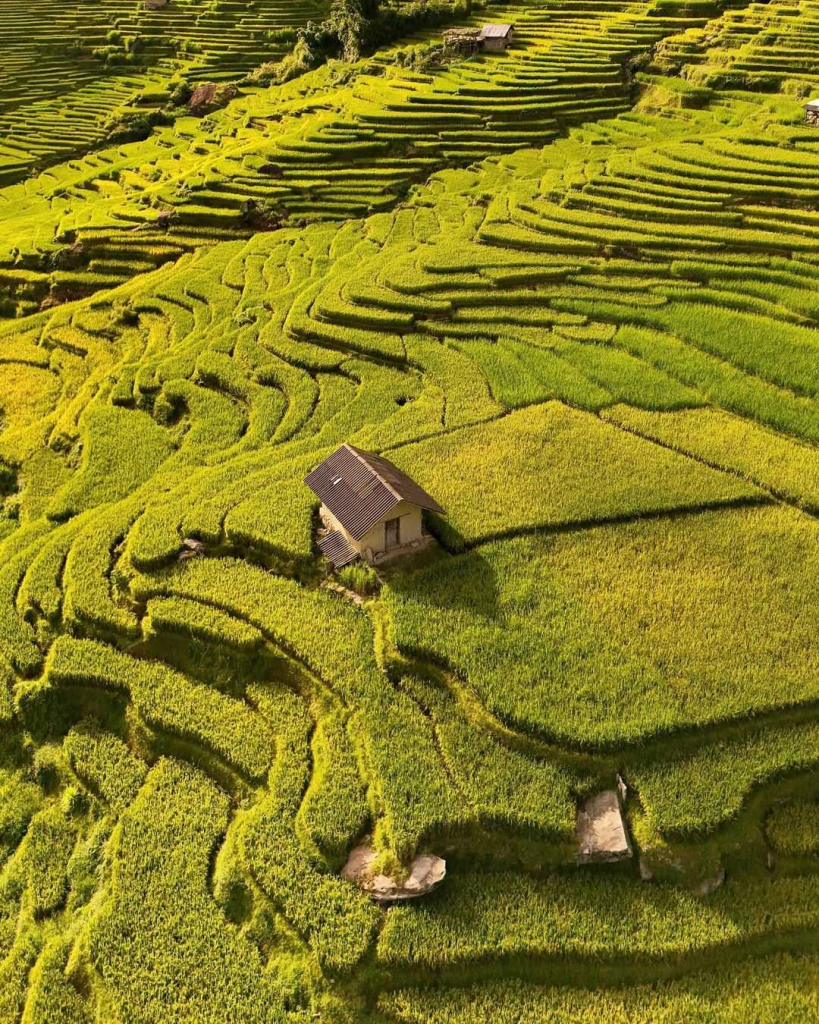
Image for illustrative purposes only. Source: Collected online.
The Rice Terraces of Muong Hoa Valley
Stretching as far as the eye can see, the rice terraces surrounding Ta Van Village are living works of art carved by generations of farmers. During spring, the terraces shimmer like mirrors reflecting the sky, while in autumn they transform into waves of gold rippling through the valley. Every season offers a new perspective — each equally mesmerizing.
The terraced fields are not just beautiful; they’re an example of sustainable agriculture and human creativity. Locals plant, flood, and harvest entirely by hand, maintaining techniques passed down for centuries. Watching them work is both humbling and inspiring, as it connects visitors to the deep respect for nature that sustains mountain life.
Why the terraces fascinate travelers:
- Dynamic seasonal colors: silver in planting season, gold in harvest.
- Panoramic viewpoints perfect for photography.
- A living symbol of harmony between people and earth.
Streams, Bridges, and the Flow of Life
Running through the heart of the valley, the Muong Hoa River winds gracefully past Ta Van’s wooden homes and green fields. Small bamboo and suspension bridges link one hamlet to another, turning every crossing into a small adventure. The gentle sound of flowing water follows you everywhere, bringing a sense of calm to each walk.
Early in the morning, villagers can be seen washing vegetables, collecting water, or fishing by the riverbanks — moments that reflect the intimate relationship between daily life and the landscape. This connection between people and nature makes every step in Ta Van feel alive and authentic.
Highlights along the river:
- Rustic bridges ideal for scenic photos.
- Children playing near the water at sunset.
- Reflective surfaces capturing mountains and clouds.
The Charm of Morning Mist and Mountain Air
At dawn, Ta Van Village is often veiled in soft fog that lingers above the fields and rooftops. As sunlight filters through, the mist begins to lift, revealing green slopes and distant peaks. The air is crisp and filled with the scent of wet soil and blooming rice. It’s a moment of pure tranquility — one that defines the magic of Sapa mornings.
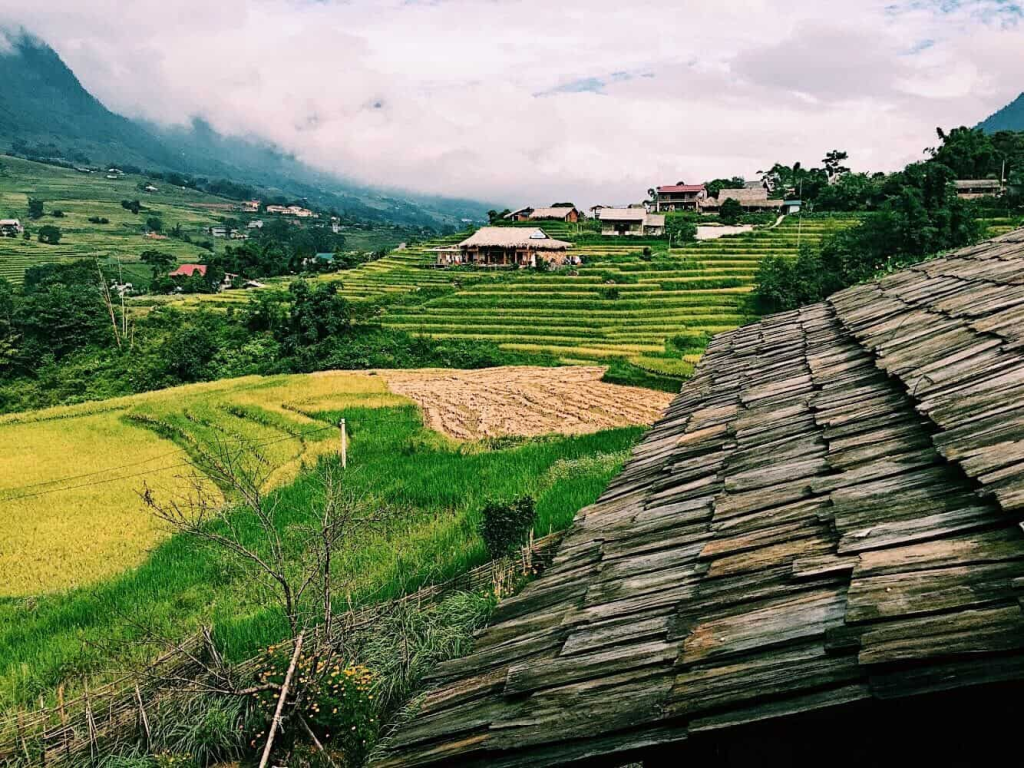
Image for illustrative purposes only. Source: Collected online.
This natural atmosphere makes Ta Van ideal for meditation, photography, or simply slowing down. Standing on a hillside watching the clouds drift through the valley feels like witnessing the world’s first breath.
When to experience the misty mornings best:
- Early morning before 8 a.m. for the softest light.
- Between March and May for clear skies and new crops.
- Between September and November for warm tones and harvest hues.
Together, these elements — terraces, rivers, and mist — weave Ta Van’s identity into a living tapestry. The village’s natural beauty isn’t just scenery; it’s the soul of a landscape that continues to inspire peace and gratitude in everyone who visits.
3. Life and Culture in Ta Van Village
The beauty of Ta Van Village extends far beyond its landscapes. Its true charm lies in the warmth, resilience, and traditions of the people who live there. The village is home to several ethnic minorities who have preserved their customs for generations. Together, they form a rich cultural mosaic that gives Ta Van its heart and authenticity.
Ethnic Communities in Harmony
Ta Van Village is one of the few places in northern Vietnam where multiple ethnic groups live side by side. The Giay, Hmong, and Dao communities coexist peacefully, sharing not only the valley’s fertile land but also mutual respect for nature and culture. Each group brings distinct colors, clothing styles, and spiritual beliefs, yet all are united by their harmony with the environment.
Walking through the village, visitors might hear the gentle hum of Hmong women weaving, smell the scent of wood smoke from Giay kitchens, or see Dao children running barefoot through the fields. Every detail tells a story of coexistence and respect.
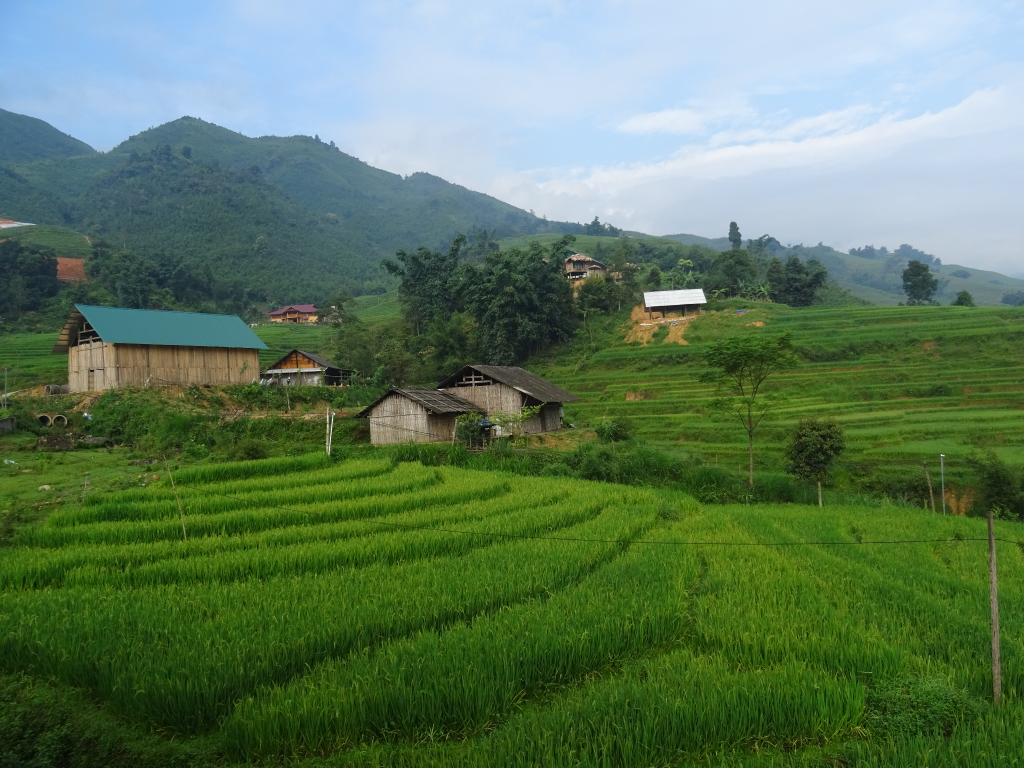
Image for illustrative purposes only. Source: Collected online.
Ethnic diversity highlights:
- Giay people: Known for their wooden stilt houses and vivid embroidered clothes.
- Hmong people: Skilled in silver-making and indigo-dyed textiles.
- Dao people: Recognized by red headscarves and traditional herbal remedies.
This blend of traditions turns Ta Van into a living museum of culture — not curated, but lived daily.
Daily Life and Traditional Occupations
Life in Ta Van flows gently, dictated by the seasons. Mornings begin with farmers heading to the terraces, their silhouettes framed by mist and light. Women often gather at home to spin thread, dye fabric, or cook over open fires, while children play or help tend buffaloes. Despite the simplicity, there’s a sense of balance — work, family, and community woven together seamlessly.
Many residents now participate in eco-tourism and handicraft workshops, sharing their skills with visitors while maintaining their traditional livelihoods. Guests who join in often describe the experience as grounding and humbling — a reminder of life’s quiet joys.
Traditional activities visitors can observe or join:
- Rice planting and harvesting alongside locals.
- Weaving and batik dyeing workshops.
- Preparing herbal baths or local delicacies.
Each activity reflects pride in heritage and an eagerness to share it.
Festivals, Faith, and Folk Traditions
The spiritual life of Ta Van Village is deeply intertwined with the natural world. Ancestor worship, harvest festivals, and rituals of gratitude mark the year’s rhythm. During the Lunar New Year, the air fills with laughter, music, and the scent of sticky rice cakes being steamed. The Giay celebrate “Roong Pooc” — a field festival that honors the land and welcomes a prosperous farming season.
Visitors lucky enough to attend these events often describe them as magical: vibrant costumes, rhythmic drumbeats, and heartfelt dances performed under the stars. Even ordinary days feel ceremonial here, as small acts of kindness and reverence define everyday life.

Image for illustrative purposes only. Source: Collected online.
Notable cultural practices:
- Roong Pooc Festival: Prayers for good harvests and community blessings.
- Traditional dances: Accompanied by bamboo flutes and drums.
- Spiritual rituals: Honoring nature spirits and ancestors.
In Ta Van Village, culture is not confined to museums or performances — it’s a living, breathing part of every moment. Through its people, visitors discover the true essence of Sapa: a place where tradition thrives in harmony with nature, and where every smile carries the weight of history and hope.
4. Staying in Ta Van: Homestays and Local Hospitality
The best way to truly experience Ta Van Village is by staying with the people who call it home. Homestays here are more than just accommodation — they are gateways into the daily life, traditions, and warmth of the mountain communities. Surrounded by rice fields, bamboo groves, and misty hills, each stay offers a blend of rustic charm and genuine connection.
Homestays in the Heart of Nature
Homestays in Ta Van Village are typically family-run wooden houses built on stilts overlooking the valley. Many are designed with simple comfort in mind: soft bedding, warm blankets, and balconies that open to endless mountain views. Some modern homestays add small touches — hot showers, Wi-Fi, and cozy fire pits — but they still retain the authenticity that makes Ta Van unique.
Staying here feels like being welcomed into a family rather than checking into a hotel. Guests share meals, stories, and laughter with their hosts, learning how everyday life unfolds in the highlands. In the evening, the valley glows with oil lamps and firelight, while the sound of cicadas fills the night air.
Highlights of the homestay experience:
- Warm hospitality and family-style meals.
- Stunning views of rice terraces and rivers.
- Opportunities to join local activities and crafts.
- Affordable prices supporting sustainable tourism.
Every sunrise seen from a Ta Van homestay reminds visitors that the most memorable luxury is authenticity.
Taste of the Highlands: Local Cuisine
Food plays a central role in every visit to Ta Van. Meals are fresh, hearty, and made from ingredients grown or gathered nearby. Breakfast might include sticky rice, boiled corn, or pancakes with local honey. Dinners, on the other hand, are communal feasts — shared with hosts and other travelers at a long wooden table.
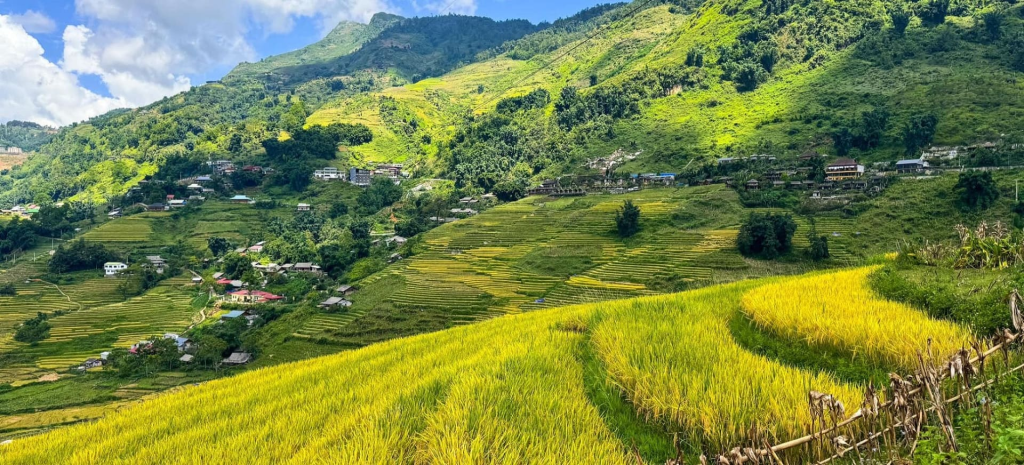
Image for illustrative purposes only. Source: Collected online.
Signature dishes often reflect both local creativity and resourcefulness. Bamboo-tube rice (com lam), smoked buffalo meat, and fresh mountain vegetables are staples, often paired with a sip of homemade corn or rice wine. Every meal tells a story — of labor, love, and the abundance of the land.
Must-try dishes in Ta Van Village:
- Com lam: Sticky rice steamed inside bamboo tubes.
- Thang co: Traditional horse meat stew, unique to the Hmong.
- Smoked buffalo: A flavorful delicacy served on festive occasions.
- Corn wine: Locally brewed spirit shared during meals and celebrations.
Sharing food here isn’t just dining — it’s an act of connection, gratitude, and celebration.
Evenings of Culture and Connection
After sunset, life in Ta Van Village slows down, but the evenings are often filled with warmth and laughter. Locals sometimes organize cultural exchanges — performances of traditional dance and music by young villagers dressed in colorful garments. Guests are invited to join, clap along, or simply sit by the fire enjoying the rhythm of drums and flutes.
When the night quiets, travelers can step outside to see a sky scattered with stars. The air feels pure and cool, and distant sounds — a dog barking, a stream flowing — remind you of how far you are from the noise of cities.
Why evenings in Ta Van are unforgettable:
- Peaceful atmosphere and sense of togetherness.
- Cultural performances that celebrate local identity.
- Clear night skies perfect for stargazing.
Staying in Ta Van Village isn’t just about where you sleep — it’s about who you meet, what you learn, and how deeply you connect. Each homestay visit is an exchange of stories, smiles, and traditions, leaving behind memories that last long after the mountains fade from view.
Read for more information:
- Fansipan Cable Car: Reach the Roof of Indochina in Minutes
- Sapa Tour 2 Days 1 Night: A Short but Stunning Escape into Vietnam’s Highlands
- Muong Hoa Valley: Trek Through Sapa’s Stunning Rice Terraces
At Abite.asia, we specialize in curated Vietnam tours for international travelers, ensuring an authentic and hassle-free experience. Let us take care of your journey so you can fully embrace the beauty of Vietnam. Contact us today at +84363770835 to start planning your adventure!



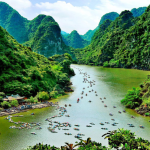

Leave a Reply